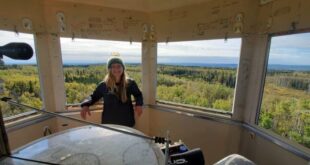'It's extreme frustration … We shouldn't be in this position again,' veteran fire ecologist says

As night fell over his Kelowna, B.C., home last week, Scott Sieben looked to the far side of Okanagan Lake and studied the menacing, orange glow he'd come to recognize all too well. Nearly 20 years to the day after he'd lost his own home to wildfire, another one was racing down the opposing hillside and reducing dozens of homes to ruins.
Then his son James called.
The McDougall Creek wildfire had jumped from the western edge of the lake toward James's home in Lake Country, about 45 kilometres north of Scott's. James and his partner were packing up and leaving, just as his parents had in August 2003.
Two generations, two decades, two evacuations as wildfire burned through a hot summer night in mid-August.
"I said, 'OK, great, make sure you have all your documents and things like you really need and you know feel free to come here and stay,'" Scott Sieben, 58, calmly recalled in an interview.
"Once he was out of the area where the fires were hitting, it was a huge, huge relief for us."
Experts say the "eerie" similarities between the Okanagan Mountain Park fire in 2003 and the McDougall Creek wildfire last week are a sign that officials haven't done enough work on fire prevention and mitigation in the last 20 years, again leaving B.C. vulnerable at a time when climate change is making fires worse.
What's "frustrating," one ecologist said, is that the advice on how to prevent the next fire is still the same.
Fires 'behaved very much the same way,' experts say
Scott Sieben and his wife moved into their home in the coveted hillside Kettle Valley subdivision in the spring of 2003, with three-year-old James and his three-month-old sister in tow.
"I was driving around looking for a new home…. There were just tons of swing sets and you know playgrounds, so we decided at that time that it would be a great place for us to bring up our family," Scott said.
The Okanagan Mountain Park fire started near Rattlesnake Island on Aug. 16, 2003. The Siebens' home of less than four months was the last in their row to burn seven days later.
"It's something I would never wish on my worst enemy," said Sieben, who is also principal at Mount Boucherie Secondary School in West Kelowna.

"Was it hard to lose some mementos and and lose some memories that we had and you know, some things that we wanted to keep forever and ever? Absolutely it was," he added.
"But as you know, my wife and I said, 'We're safe and our kids are safe.' And when we talked to all of our neighbours, all of their families were safe too. To me, that's the greatest, greatest thing."
James Sieben and his partner evacuated their home and stayed with his dad, before leaving to Victoria on a pre-planned trip. His home was untouched.
Hundreds of kilometres west, Robert Gray monitored the fire's spread last week from his home in B.C.'s Fraser Valley. A wildland fire ecologist of 43 years, Gray saw similarities from 2003.
"They both behaved very much the same way: Both high intensity, high severity fires and the effects are very similar.
"We have a very dense landscape, we have a lot of dead trees, lots of fuel on the forest floor and that is basically that's what drives fire behaviour, that and the weather of the time of the fire. So those landscapes have the very same characteristics: high density, heavy fuels, rugged terrain, steep slopes. And the weather patterns are very similar: hot, dry, windy conditions," he added.
The Okanagan Mountain Park fire is still one of the most well-known fires in B.C. history: it caused $200 million in damage, forced 33,000 people to evacuate their homes and destroyed 239 houses.
The McDougall Creek fire is smaller in size, but still forced more than 10,000 people to flee at its peak and has damaged or destroyed at least 181 properties in West Kelowna, Kelowna, Westbank First Nation and surrounding areas.
For all their similarities, Prof. Mike Flannigan said this year's fire is part of a more recent pattern.
There are a litany of reasons our fire seasons are getting worse, but climate change is a key factor. The larger, aggressive fires of today are also more likely to burn homes than they were decades ago simply because there are more available to burn.
"There's obviously been more development since 2003. So there's more people on the landscape, there's more businesses on the landscape today as opposed to 20 years ago," said Flannigan, who is a professor of wildland fire at Thompson Rivers University in Kamloops, B.C.
"It was kind of eerie, the timing," he added. "I knew the 20th anniversary was coming and then we saw things unfold last Thursday and I thought, 'Holy crap…. Here we go.'"
2003 advice still needs to be followed
After 2003, the British Columbia government asked former Manitoba premier Gary Filmon to review the fire season. In his final report, Filmon made 42 recommendations, 18 of which related to fire prevention and mitigation.
The report warned more severe wildfires were in the province's future if officials didn't take action to get rid of fuels like seedlings, shrubs and wood debris in forests close to communities — a practice known as prescribed burning, which prevents intense wildfires and replacing them with "more frequent, well-timed, well-planned low-intensity fires."
In a statement, the B.C. Wildfire Service says the province invested approximately $484 million into a number of initiatives to mitigate fire risk since 2004. Today those programs include ones for homeowners and communities, as well as Crown Land Wildfire Risk Reductions which includes cultural and prescribed burning.
The funding has significantly increased since the 2017 wildfire season, the statement read.
Last year, B.C.'s budget set aside $145 million over three years for Emergency Management B.C. and the B.C. Wildfire Service to launch the province's transition to a more "proactive approach'' to wildfire preparedness and response.
"For the B.C. Wildfire Service, this marks a transition toward year-round firefighting and risk mitigation," Finance Minister Selina Robinson told the B.C. Legislature at the time.

The ministry said the funding would be used to help the wildfire service bolster its permanent, year-round staffing so teams could focus on all aspects of emergency management during fire season — including prevention and mitigation, preparedness, response and recovery.
In another report this June, the B.C. Forests Practices Board said the provincial government still needed to undertake a "paradigm shift" in its forests management plan because current risk mitigation plans leave forests "severely vulnerable" to fire. Again, that report called for more prescribed burns.
In its statement, the B.C. Wildfire Service said "the province is committed to expanding the safe use of cultural and prescribed fire in partnership with First Nations."
Three such burns happened in the 2020/21 fiscal year, the service said, with 15 completed out of a target of 20 in 2022/23. The target for this year is 40.
Preventative spending saves money, reports say
Gray and Flannigan said governments need to spend more on prevention and mitigation, citing studies showing prevention to be a worthwhile investment with more severe weather in the forecast as a result of climate change. In 2019, Public Safety Canada estimated every dollar spent on mitigating future disasters could save roughly $6 in recovery costs down the road.
A U.S. Federal Emergency Management Agency report in 2018 found Americans saved $6 US for every dollar spent.
Two decades ago, Filmon agreed.
"Another area of clear consensus was that concentration of resources and effort on issues that anticipate, prevent and prepare for disasters is a better investment than on expenditures made in coping with disasters," wrote Filmon in his 2004 report.
"We believe that governments have a once-in-a-lifetime opportunity to implement risk reduction policies and legislation while the devastation of Firestorm 2003 is fresh in the public's mind and the costs and consequences of various choices are well understood."

Both Gray and Flannigan said the consistency in fires is painful.
"Every summer is frustrating. And it's not just me," said Gray, who offered his expertise for the Filmon report.
"We watch another disaster unfolding and we certainly hope and pray that no one gets hurt or killed in these things and that all the damage is just homes. Hate to say that, 'just homes,' but it's not people," he added.
"It's extreme frustration and it leads to depression and anger. We shouldn't be in this position again."
Sieben said he "never" would've thought his son would experience a wildfire evacuation like his parents did, let alone seeing that scenario nearly 20 years later to the day.
"It's one of those things where where you realize that Mother Nature is really powerful," he said.
*****
Credit belongs to : www.cbc.ca
 MaharlikaNews | Canada Leading Online Filipino Newspaper Portal The No. 1 most engaged information website for Filipino – Canadian in Canada. MaharlikaNews.com received almost a quarter a million visitors in 2020.
MaharlikaNews | Canada Leading Online Filipino Newspaper Portal The No. 1 most engaged information website for Filipino – Canadian in Canada. MaharlikaNews.com received almost a quarter a million visitors in 2020.







